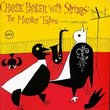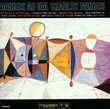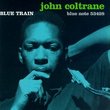| All Artists: Charlie Parker, Miles Davis Title: Blue Bird: Legendary Savoy Sessions Members Wishing: 1 Total Copies: 0 Label: Definitive Spain Release Date: 9/27/2005 Album Type: Import Genres: Jazz, Pop Styles: Swing Jazz, Bebop Number of Discs: 1 SwapaCD Credits: 1 UPC: 822165441821 |
Search - Charlie Parker, Miles Davis :: Blue Bird: Legendary Savoy Sessions
 | Charlie Parker, Miles Davis Blue Bird: Legendary Savoy Sessions Genres: Jazz, Pop
Compiled by experts on Parker, this CD issue contains six sessions by Parker's vintage 1945-1948 band, featuring two young musicians who were his best and most efficient collaborators (Miles Davis & Max Roach), plus tw... more » |
CD DetailsSynopsis
Album Description Compiled by experts on Parker, this CD issue contains six sessions by Parker's vintage 1945-1948 band, featuring two young musicians who were his best and most efficient collaborators (Miles Davis & Max Roach), plus two pianists who left their mark on the evolution of Bop (Bud Powell & John Lewis). The first session also features Dizzy Gillespie playing piano. 2005, 20-bit remastered edition from Definitive Records with new cover sleeve, artwork and photographs. Similar CDs
|
CD ReviewsA Must-Have for any Jazz Devotee Victor W. Chapman | Portland, OR USA | 04/03/2010 (5 out of 5 stars) "This is a truly fine and unusual album. Not only is it great Charlie Parker; it is also great Charlie Parker well before the culminating 52nd street Bebop frenzy set in. That happened in 1952-3, and these sessions are recorded in 1945, 1947, and 1948.
Don't get me wrong. I love Bop, and you can hear a lot of Bip-boppin' emerging on many of the songs on this CD, (e.g., "Donna Lee.") I do hold that the frenzy at Mindy's and clubs nearby was terribly hard on the music as well as the musicians. Few would dispute the second point. The massive drug use in particular spelled premature death for all too many boppers in the Fifties. They kicked before they were fairly started. I will also say what many refuse to say, that the music was also as often crippled as it was enhanced by drugs. Both Powell and Parker, in particular, would start high, gleam sharp and beautiful in spurts, and then end in splattering, even repetitive confusion. You will find none of that on these songs. They are disciplined, yet creative. They are occasionally "rough" as compared with what the few survivors such as Dizz later produced. Yet the energy and collaborative creativity overall are amazingly intense. No wavering or wandering due to extra stimulants here. Collaboration is the key word. Again, by the early Fifties bop had largely become a music of inspired solos. Sure there was a chorus theme that all returned to in between solos, but that chorus increasingly became perfunctory, like a book end, to separate this brilliant soloing book from that. This is emphatically not the case in these sessions. The group blowing is just as inspired as the solos. Collaboration. This is not a Bird album, or even, despite the title, a Bird/Davis album. Each cut is a group effort, with every member equally important, all the time. And what groups! Beyond the title two there's Max Roach, Bud Powell, Dizzy Gillespie, and John Lewis...and that's just the famous ones. The others include Curley Russell, Nelson Boyd, and Tom Potter, all primo bassists - and Duke Jordan, a terrifically sensitive pianist... they all contribute just as much as those who later became famous. What you're getting here is a deeply exciting listen to all these fabulous musicians, who, young as some of them were (Miles was only 18 in 1945), were each master of his instrument and vision, and already well under way on his musical journey. Here you will find brilliantly fresh examples of what would become Bop standards: "Parker's Mood," "Now's the Time," and "Billie's Bounce." And there's simply celestial work to be found even in the "unknown" songs, such as Mile's racing mute and Duke's delicate, moving statement on "Bird Gets the Worm." This music has the freshness, simplicity, and power of Hemingway's earliest stories. The tunes are full of youth, talent, hope, and Spring. Such joys are rare in any art form. Don't miss them. A word on the recording quality, so-called. By modern standards, this material is primitively recorded in primitive settings. In one photo of Parker in the liner notes you see that the studio's acoustics were maintained by hanging big thick canvas gym mats over all surfaces. The equipment is analog and has not been "re-recorded" in digital. You should know that this reviewer LIKES analog and is grateful that the producers have chosen not to tinker with the original sound as it was born and gathered. It really is true: Analog has a full "fat" sound that satisfies far more deeply than the clear but terribly thin peepings of Digital. There are many musicians who liked that fat sound, too, and even cultivated it on their instruments. Bird and Bean are two cases in point. Hawkins' well-known "buttery" sound fits hand in glove with Analog, and in many cases has been seriously injured, in my opinion, by Digital re-releases. In any case, if you prefer digital, you may have some problems with the "thick" analog sound of this recording. If, like me, you're an analog freak, you're in for a treat. Whichever, coming back to the first and main point, if you love Jazz in general and Bop in particular, you can't afford to miss this album. Buy it, and enjoy." |

 Track Listings (23) - Disc #1
Track Listings (23) - Disc #1

